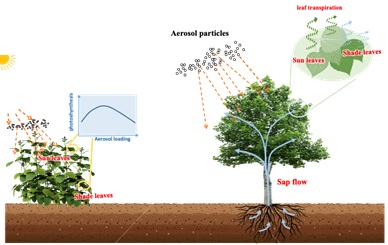Human activities have caused a rapid increase in atmospheric aerosol concentration. Changes in solar radiation and micro-meteorological environments under high aerosol loadings can affect photosynthesis and water use of plants, thereby altering ecosystem carbon and water cycles. However, there are few field observations on how aerosols affect plant photosynthesis and water use at leaf and individual scales, and the underlying mechanisms are still unclear.
The cyclical fluctuations in aerosol loading in the North China Plain provide a unique opportunity to study aerosols' effect on plant physiological responses. A research group led by Prof. LIU Lingli from the Institute of Botany, Chinese Academy of Sciences (IBCAS), studied the impacts of aerosols on crop photosynthesis and tree water use under cloudless days by combing field observations, mechanistic modelling, and satellite-retrieved datasets. The studies shed light on the mechanism of aerosol loading altering terrestrial carbon and water cycles.
Recently, these studies were published online in Geophysical Research Letters and Journal of Ecology respectively.
The researchers found that crop photosynthesis showed bell-shaped responses to aerosols at leaf, canopy and regional scales. Crop photosynthesis reached the maximum value under intermediate aerosol conditions.
Further analysis suggested that the changes in direct and diffuse radiation and the concurrent high air humidity were the main reasons leading to the non-linear response. Meanwhile, the background meteorological conditions could regulate the response curve of crop photosynthesis to aerosols.
The researchers also conducted intensive field observations on leaf transpiration and stem sap flow of planted poplar saplings. They identified that high aerosols reduced sun leaf transpiration significantly by accompanying low vapor pressure deficit (VPD), but had little effect on shade leaf transpiration. It is because that the positive effect of increased stomatal conductance induced by higher diffuse radiation offset the negative effect of low VPD.
Similarly, transpiration at the individual level (i.e. stem sap flow density) also decreased under high aerosols. Furthermore, aerosols improved the resistance of plant water use to meteorological drought at both leaf and individual levels.
These results indicated that plant water use becomes more conservative under high aerosol loadings.
“These findings showed that high atmospheric aerosols suppress crop photosynthesis and tree water use, and highlight the importance of understanding biophysical mechanisms of aerosol-meteorology interactions.” said Prof. LIU Lingli, the author for correspondence.

A clean day v.s. a heavy aerosol loading day (Image By LIU Lingli)

Aerosol alters leaf photosynthesis, leaf transpiration and sap flow density (Image by WANG Xin)
Article Link:
https://agupubs.onlinelibrary.wiley.com/doi/10.1029/2020GL091893
https://besjournals.onlinelibrary.wiley.com/doi/10.1111/1365-2745.13633
Contact:
Email: lingli.liu@ibcas.ac.cn
Institute of Botany, Chinese Academy of Sciences
Human activities have caused a rapid increase in atmospheric aerosol concentration. Changes in solar radiation and micro-meteorological environments under high aerosol loadings can affect photosynthesis and water use of plants, thereby altering ecosystem carbon and water cycles. However, there are few field observations on how aerosols affect plant photosynthesis and water use at leaf and individual scales, and the underlying mechanisms are still unclear.
The cyclical fluctuations in aerosol loading in the North China Plain provide a unique opportunity to study aerosols' effect on plant physiological responses. A research group led by Prof. LIU Lingli from the Institute of Botany, Chinese Academy of Sciences (IBCAS), studied the impacts of aerosols on crop photosynthesis and tree water use under cloudless days by combing field observations, mechanistic modelling, and satellite-retrieved datasets. The studies shed light on the mechanism of aerosol loading altering terrestrial carbon and water cycles.
Recently, these studies were published online in Geophysical Research Letters and Journal of Ecology respectively.
The researchers found that crop photosynthesis showed bell-shaped responses to aerosols at leaf, canopy and regional scales. Crop photosynthesis reached the maximum value under intermediate aerosol conditions.
Further analysis suggested that the changes in direct and diffuse radiation and the concurrent high air humidity were the main reasons leading to the non-linear response. Meanwhile, the background meteorological conditions could regulate the response curve of crop photosynthesis to aerosols.
The researchers also conducted intensive field observations on leaf transpiration and stem sap flow of planted poplar saplings. They identified that high aerosols reduced sun leaf transpiration significantly by accompanying low vapor pressure deficit (VPD), but had little effect on shade leaf transpiration. It is because that the positive effect of increased stomatal conductance induced by higher diffuse radiation offset the negative effect of low VPD.
Similarly, transpiration at the individual level (i.e. stem sap flow density) also decreased under high aerosols. Furthermore, aerosols improved the resistance of plant water use to meteorological drought at both leaf and individual levels.
These results indicated that plant water use becomes more conservative under high aerosol loadings.
“These findings showed that high atmospheric aerosols suppress crop photosynthesis and tree water use, and highlight the importance of understanding biophysical mechanisms of aerosol-meteorology interactions.” said Prof. LIU Lingli, the author for correspondence.

A clean day v.s. a heavy aerosol loading day (Image By LIU Lingli)

Aerosol alters leaf photosynthesis, leaf transpiration and sap flow density (Image by WANG Xin)
Article Link:
https://agupubs.onlinelibrary.wiley.com/doi/10.1029/2020GL091893
https://besjournals.onlinelibrary.wiley.com/doi/10.1111/1365-2745.13633
Contact:
Email: lingli.liu@ibcas.ac.cn
Institute of Botany, Chinese Academy of Sciences
